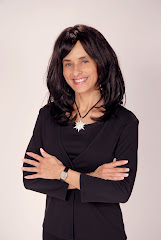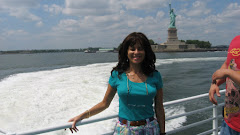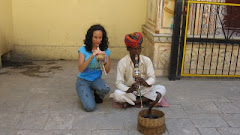



 Cairo from cruise NCL December 15-16, 2009
Cairo from cruise NCL December 15-16, 2009After connecting With Carolyn via Cruise Critic, I joined her group on the Cairo overnight tour with MemphisTours.com. There were 13 in our group. We booked our hotel,
The Cairo Marriott Hotel & Omar Khayyam Casino, separately. I used reward points. The hotel is a former palace, built in the style of Versailles, to impress foreign dignitaries for the ceremony of opening of The Suez canal www.Cairomarriotthotel.com (description later in this post)
Day 1A 5AM wake-up call found me excited about the adventure that awaited me.
My room service breakfast arrived on time and I met our group in the lobby (near reception) at 6:30AM. After disembarking at 7AM, we waited 20 minutes for our tour guide to arrive (much longer than all the other groups). We knew the drive to Giza was a 3-hour journey. We did not leave the port until 8AM—it seemed we were the last group to depart. Our van was old and not well-maintained.
In addition to our English speaking tour guide were the driver and a security professional dressed in black and packing a weapon, for our protection. Later, we realized this was standard protocol. Security is a major issue in Egypt—even the museums have metal detectors. As a result, I felt safer.
One of the first lessons from our tour guide was how to say, no thank you.
La’ Shokran. He insists it will help deter the profoundly aggressive Giza vendors. (I kept it written inside my hand and referred to it periodically).
As we rode thru
Alexandria, our guide pointed to sites: the library, the largest in the world; the stadium, the 2nd largest in the world.
I was surprised to see so many women wearing the full body abeya and for those not fully covered-they covered their heads.
There was such a mix of old and new.
Of note,
Egypt was dominated by foreigners for 2600 years ending in 1952 with the 1st of only 3 Egyptian rulers.Our
Egyptologist joined us, en route. It took a while to adjust our ear to her dialect. She immersed herself in the study of Egyptian history and antiquities for more than six years. She is passionate and conscientious. She kept her head covered but wore western attire.
The ride was long yet well worth the time investment:
I was moved to tears when the pyramids finally emerged on the horizon. It is for me, one of the most spectacular sites I have seen. It was the visit of a lifetime—a dream come true—to visit the Pyramids at Giza!!I was in heaven!
Our first stop was the
great pyramid, Khufu/Cheops (c. 2589BC). Next we stopped at a site where
all 3 pyramids (tombs for father, son, and grandson) can be viewed. More great photo opps here. Then we walked over to the area where camel owners took riders on tours. Several in our group took camel rides. I took photos with camels, instead.
Our van drove us the end point of the
camel caravan. There, we waited for the camel riders and took more photos. I got one of my best shots from this point.
Next, we drove to the famously photographed point where
the Great Sphinx dominates the scene and the tomb of its creator, the Middle Pyramid of Khafre/Chephrenis, rests in the foreground. Another magnificent moment for this world traveler and lover of history.
Our guide took us inside a tomb next to the Sphinx and shared the history of its architecture. There we saw the seating for the nightly sound and light show. Perhaps I will see that on my next trip.
Of note, yes the
vendors were aggressive but I have experienced far worse (Great Wall of China, Nassau markets etc.) AND I repeatedly replied La’ Shokran. They do a lot of bait-and-switch promotions. For example: one guy showed me a packet containing miniatures of the 3 pyramids PLUS Sphinx. He shouted ONE DOLLAR. (Yes, they take dollars in many tourist areas). My interest was stirred because I collect miniatures of famous sites all over the world. One dollar is always a good price for me! When I expressed interest, he clarified one dollar per item—which means $4 instead of $1 for the lot. I turned away and walked ahead. He immediately lowered the price; I kept rejecting his lowered rates. Three Dollars, then two dollars he cried out! I had agreed to ONE DOLLLAR---besides, I only had a ONE DOLLAR BILL folded inside my pocket (I left my purse on the tour bus for safekeeping).
At last, he conceded, OK ONE DOLLAR! We had a deal. I was deeply satisfied with my purchase.
I came, I saw, I conquered. I would add the “marble” miniatures to my Eiffel Tower, Statue of Liberty, Roman Coliseum, Taj Mahal, Big Ben, Great Wall, Corcavado, Liberty Bell, Parthenon, Arch de Triomphe, St Louis Arch, Golden Gate Bridge, Mannekin-Pis, Irish Leprechaun, Indonesian Garuda, Vietnamese Water girl, Seattle Needle, Chicago skyline etc.
I took more photos in front of the Sphinx. A guard volunteered to take me “touching the tip of the pyramid” and “kissing” the Sphinx. They reminded me of the shots I took with The Taj Mahal.
There was so much to savor.
Next, we drove 45 minutes to
Memphis, the first capital of a united Egypt. What has been discovered there is gathered in a small, open-air museum. The first site there is the Sphinx of Memphis (largest calcite statue ever found). Naturally, many were gathered to take photographs. Most impressive, in its own viewing pavillion, was the
colossal limestone Statue of Ramses II. It fills the building and can be viewed from two levels. The detail and massive-size of the great work rendered me speechless and in awe of ancient builders.
Our last site would close by 4 so (although we were starving) we headed there next. It was
Saqqara, the site of Egypt’s earliest pyramid (c. 2650BC), the
Step Pyramid of Djoser. Once again, I was blown away by the scale and sturdiness of the structures here. This remarkable structure marks a leap forward in the history of world architecture. Until then, Egyptian royal tombs had been underground rooms, covered with low, flat, mud brick. This trailblazing work was built with stone with 6 mastabas placed on top of one another. The last stage in pyramid building, from stepped to smooth-sided, took only 65 years. The Step Pyramid was the model for later tombs including the trio at Giza, which are perfectly formed, smooth-sided tombs.
One of the highlights of Saqqara was next. We toured the
Tomb of Mereruka, with it’s famously, well preserved statue emerging from a “false” door. We toured its extensive complex of 33 underground chambers. Impressive were the prolific, intricate wall-paintings depicting hunters, tax evaders, farmers and more scenes from everyday life.
The
Pyramid of Teti was next. Some of us crawled inside the descending, narrowing passage to reach the bottom I was dreading every moment, realizing I am somewhat claustrophobic (BTW, I would do it again!). Highlights were the ceiling decorated with stars, the walls inscribed with sections of Pyramid texts, and the king’s giant basalt sarcophagus.
Lunch. FINALLY.
We went to a “traditional” (recreated for tourists, of course) village complete with bread makers and musicians for a traditional Egyptian Feast. The tastes and smells were familiar: they brought heaping platters of pita, Swarma, hummus, tzitki, lamb, chicken, salad, Baklava and more.
It really hit the spot even though we waited TOO long to dine. Next time, I will pack extra lunch. I am glad I had brought banana and a muffin from the ship!
Next, some in the group wanted to shop for cartouche jewelry. We took them there and waited long for them to order. Next, that group wanted to buy souvenirs at a cotton factory. Inside were typical, uninspiring items that I could purchase for less, in the US. Civil war almost broke out in our group because we were way behind schedule—needing to check into our hotel—during rush hour—in time to make our 8PM Nile dinner cruise. Nonetheless, some wanted to continue shopping at the massive Khan al-Khalili, one of the largest bazaars in the Middle East. Surely some in our group would get lost there AND we would undoubtedly miss our Nile Cruise. I came to Egypt to see Egypt—NOT to shop for overpriced T-shirts for distant relatives!!!! We had agreed no perfume or papyrus factories because we did not want to waste precious time buying stuff we did not NEED. Finally, we agreed to save Khan al-Khalili Bazaars for the next day, and to head directly to our hotel. Traffic was sooooo congested, we feared we would not arrive in time to check in, shower, and make the dinner cruise on time. We had spent the day in the windy sandy dessert and were in NEED of cleansing. Unfortunately, all we had time for was to check in and leave our luggage with the concierge. There was much debate about going to our rooms or not. I was the voice of reason, insisting we should give up the notion of the Nile dinner cruise if we were to attempt visiting our room in this massive former palace hotel.
FINALLY, they agreed we should head directly to our Nile cruise ship in this fiercely congested traffic.
Our people-pleasing tour guide was not helpful in guiding the decisions of this polarized first time group to Egypt.
The
Nile dinner cruise was a bountiful buffet of traditional Egyptian dishes. Entertainment was 1) belly dancer and 2) whirling dervish spinning around in his brightly colored, muti-layered, flared costume
Back to the hotel after 10PM. I explored a bit and bought few souvenirs in shop just in case there would not be sufficient time to shop at the bazaar the next day.
I was EXHAUSTED.
Here is Wikipedias description of the hotel:
The
Cairo Marriott Hotel is a large hotel situated on the River Nile in the centre of Cairo, Egypt. Once a palace built on orders from the ruler of Egypt in 1869, the hotel was converted to a by Marriott International to a modern hotel. The hotel consists of 1,089 rooms, making it one of the largest hotels in the Middle East.
The rooms are located in two identical twenty-storey buildings - the Gezira and Zamelek Towers. Situated between them on ground level is the palace and main entrance to the hotel, which reconstructed now contains the reception and administration areas. On the roof of the palace is an open-air theatre which faces the Nile.
The original palace was constructed by the Nile on orders from Khedive Ismail. He asked the architects of that time to make it resemble another palace in France, Versailles, where Empress Eugénie used to stay. The purpose for that palace was to host the French Empress Eugénie who was invited along with her husband the French Emperor Napoleon. The occasion of that invitation was the opening of the Suez Canal, which was a huge project at that time.
It is over-the-top ornate but beautiful at the same time!
Day 2Checked out of hotel and met in lobby at 7AM (I think).
First stop:
The CitadelThe Citadel, home to Egypt’s rulers for almost 700 years, was our first stop. This complex contains 4 museums, mosques, and an area that offers spectacular views of the city.
The imposing Turkish style
Mohammed Ali Mosque, built from 183-48, has become a symbol of Cairo. It is a grand structure with ornate domes, minarets, and entrance ways that echoes the great imperial mosques of the Ottoman Empire. It truly is a splendid site.
We toured the inside of this magnificent structure. I found the stories of its design, construction, and religious importance to be interesting.
Next Stop:
The Egyptian Museum. Aside from the Giza Pyramids, this museum (and the Royal Mummies room) was my favorite stop.
I could easily have spent days here with a tour guide and time to process it all, of course. It has 107 halls densely packed with displays of more than 120,000 items.
At the ground floor there are the huge statues, coins, coffins, amulets, household items, reliefs etc from the Old, Middle, and New Kingdoms. The upper floor houses small statues, jewels, Tutankhamen treasures and the royal mummy room.
King Tut ExhibitsCommencing with two life-size statues of the young king that stood guard at the entrance to his tomb, The Tutankhamun Galleries fill the upper floors east and north wings. There are more than 1700 items on display ranging from board games and hunting implements to couches and beds, and of course, the fabulous life-sized GOLD DEATH MASK.
Only 3 in our group elected to pay the extra $20 to visit the
Hall for the Royal Mummies housing eleven kings and queens. I was so impressed by how well-preserved these (more than) 3000 year-old bodies were. You can still see their teeth, nails, and hair.
More than a million and half tourists visit the museum annually, in addition to half a million Egyptians.
We agreed to not risk missing boat with a sit down lunch or with shopping in the Khan El Khalili Bazaars.
We headed directly back to ship in Alexandria. Along the way, we picked up boxed lunches of traditional Egyptian fare
It was an extremely
windy day; Our van was rocking back and forth on the way back. I was so glad we had visited the dessert the day before. The blowing sand would have blinded our views.
The ride back was especially long—almost 4 hours
In Alexandria, our tour guide pointed out major structures. It was too windy to bother getting out to see them up close and personal.
As it turns out, there was a nice bazaar, with at least 25 vendors, right outside ship in Alexandria.
I was so tired carrying my duffle that I was not in the mood for bargaining or acquiring. I only bought postcards that I mailed from Malta (NCL mailed them for me)
I will definitely return to the Giza plateau and Cairo















.JPG)










.jpg)
.jpg)



